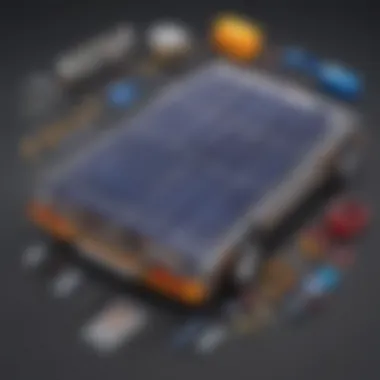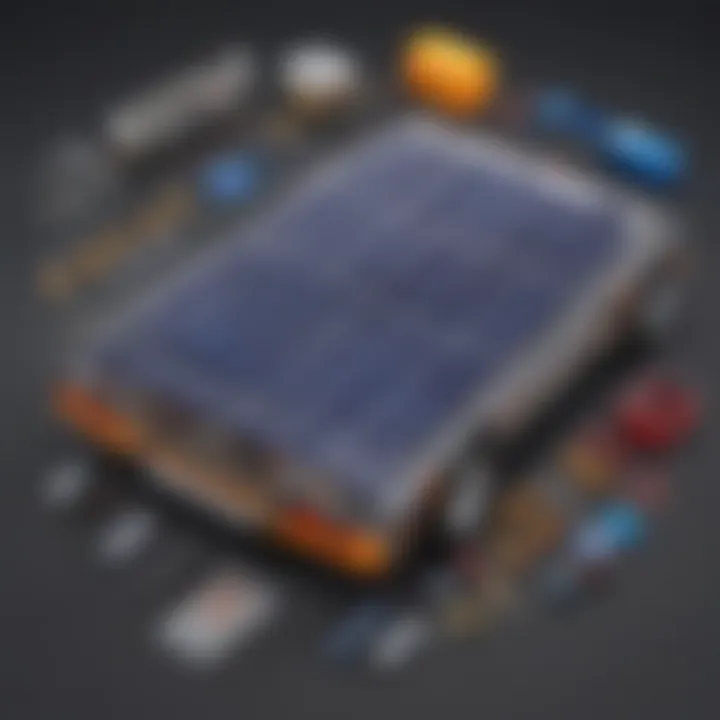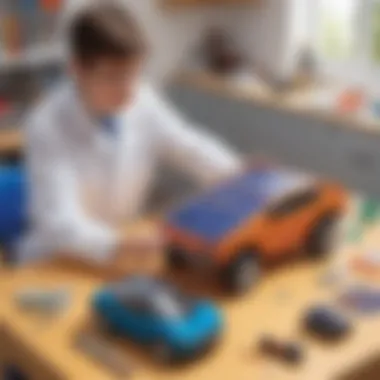Exploring Solar Panel Car Kits for Young Minds


Intro
In recent years, the world has witnessed a surge in interest surrounding renewable energy. Among the various facets of this growing field, solar energy stands out like a shining beacon of hope. Solar panel car kits offer a fantastic way for young minds to engage with this crucial aspect of science and technology. With solar panel car kits, children and their mentors can explore how sunlight can be harnessed to create energy, turning simple materials into moving vehicles.
Through building and experimenting with these kits, kids not only grasp the fundamental principles of solar power but also tap into basic engineering concepts. This hands-on experience fosters curiosity, creativity, and a passion for learning. What if we could spark a generation of scientists and innovators by simply encouraging them to play and experiment with the tools of the trade?
The following sections will open the door to an enriching journey that unveils fascinating facts, practical applications, and lively interactions with the world of science. Let's kick off our exploration by diving into some fun facts that can help frame our understanding of the topic!
Prelims to Solar Energy
When we think about the future, it’s easy to get swept up in the glimmering allure of technology and convenience. Yet, underpinning all of this is a fundamental need for energy, and increasingly, the power source we turn to is solar energy. Why is that? Let’s dig into it.
Solar energy, in its simplest form, comes from the sun. It’s the energy produced by the sun's rays, which can be harnessed to provide lighting, heating, and power for various applications, including homes, schools, and vehicles. Understanding this form of energy is crucial, especially when discussing solar panel car kits.
By exploring the topic of solar energy, we are not just learning about a source of power. We are also uncovering the stories behind renewable energy, the shift towards sustainable options, and the responsibility we hold as stewards of the planet. Engaging with solar energy gives young learners insight into engineering principles, basic science, and environmental ethics. This sets the stage for responsible citizenship.
What is Solar Energy?
Solar energy refers to the light and heat that comes from the sun. Everyday, the sun beams down an astonishing amount of energy onto our planet—about 173,000 terawatts at any given time. To put it simply, this is more than 10,000 times the world's total energy use! However, harnessing this energy takes effort and innovation.
Typically, solar energy is converted into electricity using solar panels. These panels consist of many cells that capture sunlight, converting it into usable electrical energy through a process called the photovoltaic effect. This process might sound complex, but at its core, it’s quite simple: sunlight excites electrons in the solar cells, creating an electric current. Once people understand the mechanics behind it, they can grasp how solar power becomes the electricity that runs everything from light bulbs to cars.
Key components of solar energy:
- Solar panels: The major player in capturing sunlight and converting it into electricity.
- Inverters: Devices that transform the direct current generated by solar panels into alternating current, enabling us to use it in our homes.
- Batteries: These store energy generated during the day for use at night or during cloudy days.
- Charge controllers: They manage the flow of energy to ensure batteries are not overcharged or discharged.
Understanding solar energy is like unwrapping a gift: the more you peel back the layers, the more exciting things you find. Young scientists can spark creativity and innovation by grasping these principles.
The Importance of Renewable Energy Sources
As we move into a world increasingly dependent on technology, it is vital to recognize the importance of renewable energy sources like solar energy. Unlike fossil fuels that are finite and contribute to environmental degradation, renewable sources are endless and environmentally friendly. This fundamental shift is not just a matter of preference; it’s life-altering for our planet’s future.
Why focus on renewable energy?
- Sustainability: Renewable energy sources are replenished naturally and are not at risk of depletion.
- Reducing pollution: Implementing cleaner energy sources can lead to better air quality and lower greenhouse gas emissions that contribute to climate change.
- Economic benefits: Investing in renewable energy can stimulate job creation and foster energy independence for communities and countries.
For young minds learning about science and the broader impacts of their disciplines, understanding renewable energy sources instills a sense of duty and possibility. In environmental studies or science classes, these discussions can lead to questions about solar panels, car kits, and how they can create real change.
"The greatest threat to our planet is the belief that someone else will save it." - Robert Swan
Understanding Solar Panel Car Kits
Understanding solar panel car kits is essential for grasping the broader implications of renewable energy education. These kits not only offer hands-on experience but also illustrate the principles of energy conversion, engineering, and sustainability. By engaging with solar car kits, young scientists can deepen their understanding of solar energy while developing vital skills in problem-solving and critical thinking. This section aims to demystify the components and functions of these kits, shedding light on their significance in nurturing environmentally-conscious innovators.
Definition and Components


Solar panel car kits are educational tools that combine the principles of solar energy with hands-on building activities. Essentially, these kits consist of various components that work together to create a functioning solar-powered car. The main parts typically include:
- Solar Panels: These are perhaps the star of the show. They capture sunlight and convert it into electricity, powering the car.
- Chassis: This is the frame of the car, usually made from lightweight materials like plastic or metal. It holds everything together.
- Motor: This is what gets the wheels turning. The motor uses the electric energy from the solar panels to move the car.
- Wheels: A kit wouldn’t be much of a car without wheels! They allow the vehicle to move.
- Battery (sometimes): Some kits include a rechargeable battery that stores energy from the solar panels, allowing the car to run even when the sun isn’t shining.
Together, these components provide a tangible experience for young learners, allowing them to see how solar energy can be harnessed and used in everyday applications. By building their own solar cars, children grasp not just the mechanics involved but also the underlying scientific principles, such as conduction and energy efficiency.
How Solar Panel Car Kits Work
Learning how solar panel car kits operate opens up a world of inquiry and understanding. When sunlight strikes the solar panels, it creates an electric current. This current is then directed to the motor, which powers the wheels, causing the car to move. The process is relatively straightforward but fascinating. Here’s a simple breakdown of how the energy flow occurs:
- Sunlight Absorption: As the sun shines light on the solar panels, they begin to produce direct current (DC) electricity.
- Energy Transmission: The generated electricity flows from the solar panel to the motor through connecting wires.
- Motor Activation: The current activates the motor, which then turns the wheels and propels the car forward.
"Understanding how things work creates a pathway for creating better solutions for tomorrow’s challenges."
Occasionally, the car may have some energy storage features, like a battery. If included, this battery stores excess energy harvested during sunny conditions so the car can still function on cloudy days or indoor settings. The interaction of different components, like how the solar panel outputs energy and how the motor uses it, portrays the fundamental relationship between energy production and mechanical movement.
By grasping these concepts, young learners not only engage with STEM disciplines but also cultivate an appreciation for renewable energy. This realization could inspire them to think about their role in the environment and how they can contribute to a sustainable future.
Benefits of Using Solar Panel Car Kits
When we talk about solar panel car kits, there’s more to the story than just toys that zip along in the sunlight. These kits are like tiny laboratories on wheels, teaching young minds about renewable energy and the world around them. They are tools that can shape future innovators and conscious citizens, and their benefits reach far beyond simple entertainment.
Educational Advantages for Young Minds
Young minds are naturally curious. Solar panel car kits leverage that curiosity. These kits introduce students, especially elementary school children, to the fascinating realm of science and technology in a hands-on way.
Through building and experimenting with these kits, children get to grasp fundamental concepts in physics, such as energy conversion, light absorption, and motion mechanics. For instance, by assembling a solar-powered vehicle, they can learn how sunlight can be transformed into energy, which is a crucial principle in renewable energy science. This experience doesn't just create a solid grounding in STEM principles; it also boosts critical thinking and problem-solving skills.
"Learning by doing is the key to understanding complicated subjects like physics and engineering."
Moreover, solar panel car kits promote teamwork. Kids often work in groups to build their models, encouraging collaborative skills and communication. This collaborative effort can lead to discussions about ideas and concepts that stretch our understanding of energy usage and environmental impact.
Encouraging Environmental Responsibility
The importance of environmental responsibility cannot be overstated, especially in the context of climate change. Solar panel car kits provide an engaging platform for educating children about sustainability and the significance of using renewable energy sources.
When kids see a vehicle move through the power of the sun, it makes the abstract idea of renewable energy much more tangible. They learn that fossil fuels are not the only option for energy. Instead, they can grasp that sunlight is a clean, abundant resource that can be harnessed. This understanding fosters a sense of responsibility toward the environment.
It's not just about understanding; it's also about motivating action. Children who engage with these kits often become advocates for sustainability, discussing with their peers and families the importance of clean energy. This can lead to conscious decisions at home, like reducing electricity use or even considering solar panels for their houses, influencing the whole family’s perspective toward renewable energy.
In summary, solar panel car kits not only inspire young scientists to explore but also ignite a sense of stewardship for our planet. They are a powerful medium for informing children about the critical balance we need to maintain with nature and how every little action contributes to a larger cause. By integrating fun with education, these kits prove to be invaluable tools in nurturing the next generation of environmentally conscious innovators.
Practical Applications
Practical applications of solar panel car kits go beyond tinkering and building models. They create pathways for young minds to grasp core concepts in science and technology while also addressing real-world issues. The hands-on experience that these kits offer is invaluable in fostering curiosity and engagement in renewable energy. Not only do they provide a platform for experiential learning, but they also intertwine these lessons with environmental stewardship. By working with solar car kits, children learn the essentials of solar energy, mechanics, and teamwork—skills that are increasingly relevant in today's world.
Experiments and Learning Activities


Implementing experiments with solar panel car kits can spark an array of engaging learning activities. For instance, a simple experiment might involve testing how different angles of solar panels affect the car’s speed—this teaches students about the physics of light and energy conversion.
Some potential activities include:
- Building a Race Track: Create a racecourse to score how different designs and angles perform under varying sunlight conditions.
- Material Experimentation: Use different materials for car bodies and assess which offers the best balance between weight and durability.
- Environmental Challenges: Encourage students to think critically about how sunlight availability affects their solar cars’ performance in different regions.
These activities not only keep the students engaged but also encourage critical thinking and problem-solving skills. The variety ensures that learners from all backgrounds find something that piques their interest.
Integrating Solar Kits into Curriculum
Integrating solar panel car kits into educational curricula means aligning the hands-on experiences with established learning goals. Teachers can incorporate these kits not just into science classes but also into subjects like math and art. Consider the following approaches in the classroom:
- STEM Projects: Use the kits to support STEM (Science, Technology, Engineering, and Mathematics) initiatives by engaging students in projects that require planning, executing, and reflecting on their work.
- Interdisciplinary Learning: Combine elements from environmental science and social studies to explore the impact of renewable energy on global issues. This can inspire critical discussions on climate change and sustainability.
- Student-Led Initiatives: Encourage students to showcase their projects at science fairs or community events, enhancing public speaking and presentation skills while promoting awareness about renewable energy among peers and parents.
- Discuss engineering principles while constructing and troubleshooting their cars.
- Incorporate metrics to calculate speed and efficiency, honing math skills through real-world applications.
"Learning by doing is the best way for students to understand complex topics. Through trial and error with solar kits, they can discover solutions and innovate beyond traditional learning methods."
By embedding these insights in the curriculum, educators not only enhance learning outcomes but also pave the way for students to become informed global citizens interested in sustainable practices.
Choosing the Right Solar Panel Car Kit
When it comes to solar panel car kits, selecting the right one can feel like finding a needle in a haystack. This choice isn’t just about grabbing any kit off the shelf; it’s all about focusing on quality, educational value, and the thrill of discovery. For young scientists, the right kit can spark an interest in renewable energy that lasts a lifetime.
A well-chosen solar panel car kit allows students to explore practical science in a hands-on environment. With mechanics that align closely with engineering principles, these kits can enhance critical thinking skills. Plus, they serve a dual purpose: they’re fun to build and educational to use! Thus, it’s not simply a toy; it’s a brilliant tool for budding inventors.
Factors to Consider
When pondering over which solar panel car kit to buy, several factors come into play. Taking the time to evaluate these can greatly affect the learning experience and the project’s overall success:
- Age Appropriateness: Consider the age of the child. Some kits are designed for younger kids, while others may be more complex, suitable for older students.
- Components and Complexity: A good kit should include quality solar panels, motors, and a variety of parts. Some might come with detailed instructions, while others encourage creativity and experimentation.
- Durability: Kids can be rough with their toys. Look for kits that are made from robust materials to withstand the test of time, as repeated builds can easily wear down weaker components.
- Educational Value: Eager learners will thrive on kits that not only teach them how to assemble components but also explain concepts like electricity and energy conversion.
- Reviews and Recommendations: Seek out opinions from other parents and educators on platforms like Reddit. These insights can help you find kits that live up to their hype.
- Cost: Solar panel car kits can vary widely in price. It’s valuable to weigh the educational benefits against the cost. Sometimes, spending a bit more can lead to a richer learning experience.
"Choosing the right kit can influence how much a child enjoys learning about science!"
Top Kits for Young Scientists
Now, let’s dive into some popular solar panel car kits that have caught the eye of parents and educators alike. The following options cater to a mix of ages and expertise levels:
- Elenco Solar Racer: This kit is fantastic for novice builders. It offers a simple design that illustrates how solar energy can power a vehicle, complete with easy-to-understand instructions.
- 4M Solar Engine Kit: A bit more complex, this kit lets students understand how solar energy can be transformed into movement. It’s perfect for kids ready to take their learning to the next level.
- Sunflower Solar Car Kit: Designed with environmental lessons in mind, the Sunflower kit comes with multiple configuration options, showing how solar energy can power various shapes and sizes of cars.
- Thames & Kosmos Solar Powered Car Kit: This comes with various components, teaching kids about energy, electricity, and how to convert solar power into mechanical movement. It’s engaging and deeply educational.
Each of these kits not only offers a unique building experience but promotes understanding of solar energy principles. Choosing the right solar panel car kit can empower young minds to explore, discover, and innovate.
Challenges and Limitations
As we delve deeper into solar panel car kits, it’s essential to address the challenges and limitations that come along with these kits. Understanding these elements not only helps in setting realistic expectations but also equips young scientists and educators with knowledge to troubleshoot and navigate potential pitfalls. Recognizing these challenges allows for a more enriching learning experience rather than a disheartening one.


Potential Technical Issues
Technical issues can often seem like roadblocks on the path to discovery. These kits, while exciting, may present problems that can catch users off guard. Some typical technical challenges include:
- Component Compatibility: Sometimes, the parts supplied in the kit may not fit together properly, or they may not be of compatible voltage or capacity. This issue could frustrate learners attempting to construct their solar cars.
- Power Consistency: Solar energy depends largely on sunlight. Inconsistent lighting conditions can lead to variations in power output. Cloudy weather can cripple the performance, limiting the ability of students to conduct experiments effectively.
- Battery Life: If the kits use batteries to store energy, the lifespan and charging efficiency of these batteries could vary. If a battery loses its charge quickly, kids might find their cars sputtering away during tests.
"Understanding these technical challenges can empower young learners to troubleshoot effectively and develop perseverance—a crucial skill in any scientific field."
A hands-on approach to resolve these issues not only enables problem-solving but also cultivates a sense of accomplishment and resilience.
Educational Barriers
Moreover, educational barriers can also hinder the successful integration of solar panel car kits into learning environments. Some factors to consider include:
- Limited Teacher Training: Many educators may not have extensive backgrounds in renewable energy or engineering principles. Without proper training or resources, teachers might struggle to guide students effectively.
- Resource Accessibility: In a classroom setting, not all schools may have access to the necessary resources such as adequate solar kits or space for experiments. This disparity can lead to unequal learning opportunities among students.
- Curriculum Overload: With an already packed curriculum, educators might find it difficult to integrate hands-on projects like solar kits effectively. Time constraints could result in these kits being used only superficially, missing out on their true educational potential.
Future of Solar Technology in Education
As we sit at the cusp of a greener era, the relevance of solar technology in education grows more pronounced with each passing day. The incorporation of solar panel car kits in educational contexts not only fosters an understanding of renewable energy but also cultivates critical thinking and problem-solving skills. Young learners today will become the stewards of tomorrow's planet, and empowering them through innovative tools is vital. These kits are not merely toys; they are gateways to curiosity and exploration in the realm of science.
Innovations in Solar Car Kits
In the last few years, solar car kits have undergone significant transformation, evolving from simple designs to remarkably sophisticated setups. New innovations aim to enhance learning and engagement among young learners. Some notable advancements include:
- Modular Designs: Many of the latest kits now offer modular components. This means that a child can swap parts to form different configurations. Building a solar car isn't just about following instructions anymore; it’s an exercise in creativity and engineering.
- Smart Technology Integration: Kits are now available with sensors and app connectivity. For instance, a child might control the car's movement via a smartphone app, receiving real-time data about energy output and speed. This integration promotes an understanding of how technology can provide solutions to everyday problems.
- Instructional Support: Many manufacturers have begun to create comprehensive video tutorials that help explain the science behind solar technology, making the learning process as engaging as possible. This multifaceted approach ensures that children grasp the concepts visually and practically.
These innovations not only make learning more exciting but also more relevant. Engaging with evolving technology sparks interest in STEM fields, laying a solid groundwork for future studies.
Expanding Access to Renewable Energy Education
While solar technology in education is promising, expanding access remains a challenge. Many schools, especially those in low-income areas, lack the resources to implement renewable energy projects. This gap means that countless children miss out on valuable educational experiences. To address this,
- Grants and Funding: Organizations are increasingly offering grants for educational institutions that wish to introduce renewable energy tools like solar kits. These can pave the way for schools that previously struggled to afford such resources.
- Community Workshops: Local community centers can host workshops to demonstrate the functionality and advantages of solar technology. Family-oriented events can draw in various age groups, fostering a collaborative learning environment.
- Partnerships with Companies: Educational institutions might partner with solar energy companies to secure discounted kits. Such collaborations can help in equipping classrooms while providing companies with a platform to create awareness about renewable energy.
By working together to ensure that solar technology is accessible, we can inspire a broader range of future engineers, scientists, and environmental activists. Once children realize that renewable energy is not just a distant concept but an actionable solution, they are more likely to pursue careers that contribute positively to our planet.
"The future is bright, quite literally! By investing in our children today, we foster a generation that can lead the charge toward sustainable living and innovative solutions for our ever-changing world."
Closure
Reflecting on the Role of Solar Car Kits
Reflecting on the role of solar car kits in today’s education reveals their multifaceted benefits. They're not just toys or simple construction kits; they’re gateways into the science of renewable energy. By providing a tangible way to learn about solar power, these kits allow kids to see the conversion of sunlight into energy happen in real-time. The thrill of watching a solar car zoom down the street serves as a compelling demonstration of physics, environmental science, and innovation all rolled into one.
Above all, these kits ignite passion among young scholars. Instead of remaining passive recipients of information, they become active participants in their learning journey. As they tinker and experiment, students gain an appreciation for trial and error, an important aspect of the scientific method. This involvement cultivates a mindset where inquiry and experimentation are celebrated, laying the groundwork for future scientific endeavors.
Encouraging Future Generations of Innovators
Encouraging future generations of innovators requires a collective effort to integrate more hands-on experiences like solar car kits into educational systems. By exposing children to the principles of renewable energy early on, we can nurture a generation that values sustainability and innovation. Today’s learners are tomorrow’s pioneers in green technology. As they explore the functionalities of solar cars, they might find themselves inspired to design the next generation of renewable energy solutions.
Additionally, these kits can generate important discussions around climate change and environmental responsibility. Engaging in such dialogues at an early age fosters awareness about the choices we make and their impact on our planet. Children learn that they have the power to contribute to a sustainable future and that even small inventions can lead to significant changes in society.
All in all, nurturing a mindset geared toward innovation starts with encouraging exploration through tools like solar panel car kits. Such engagement instills not just knowledge, but also a spirit of inquiry that will carry young scientists into their future endeavors, potentially shaping a world where renewable energy practices are the norm.







